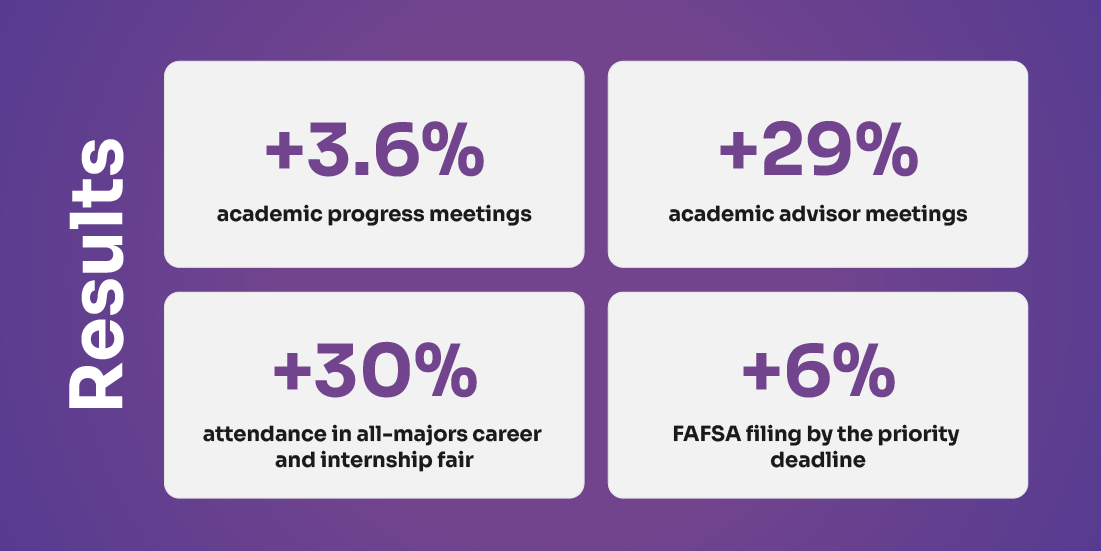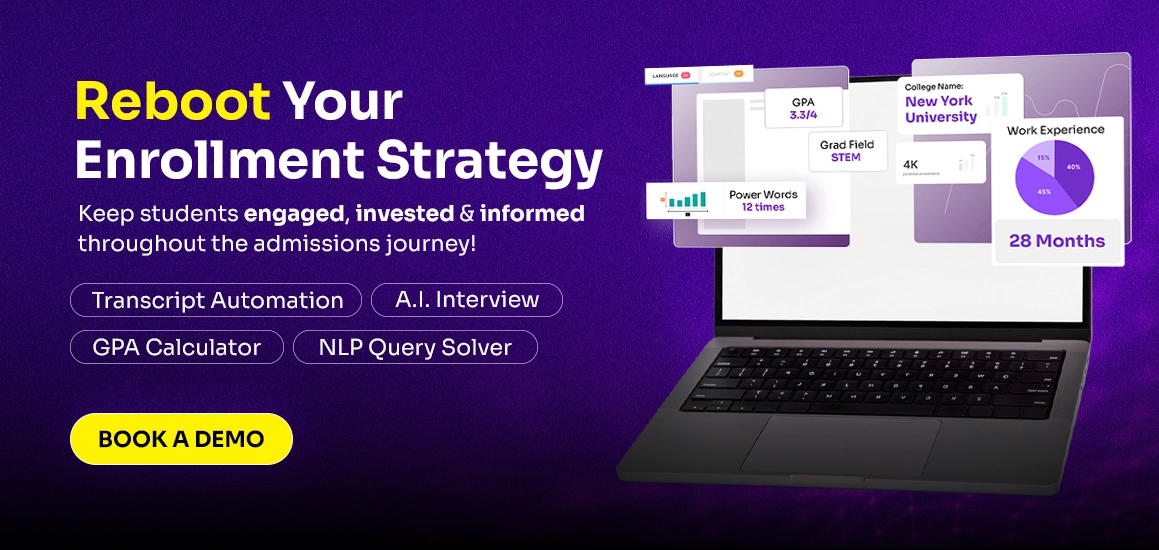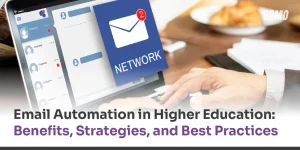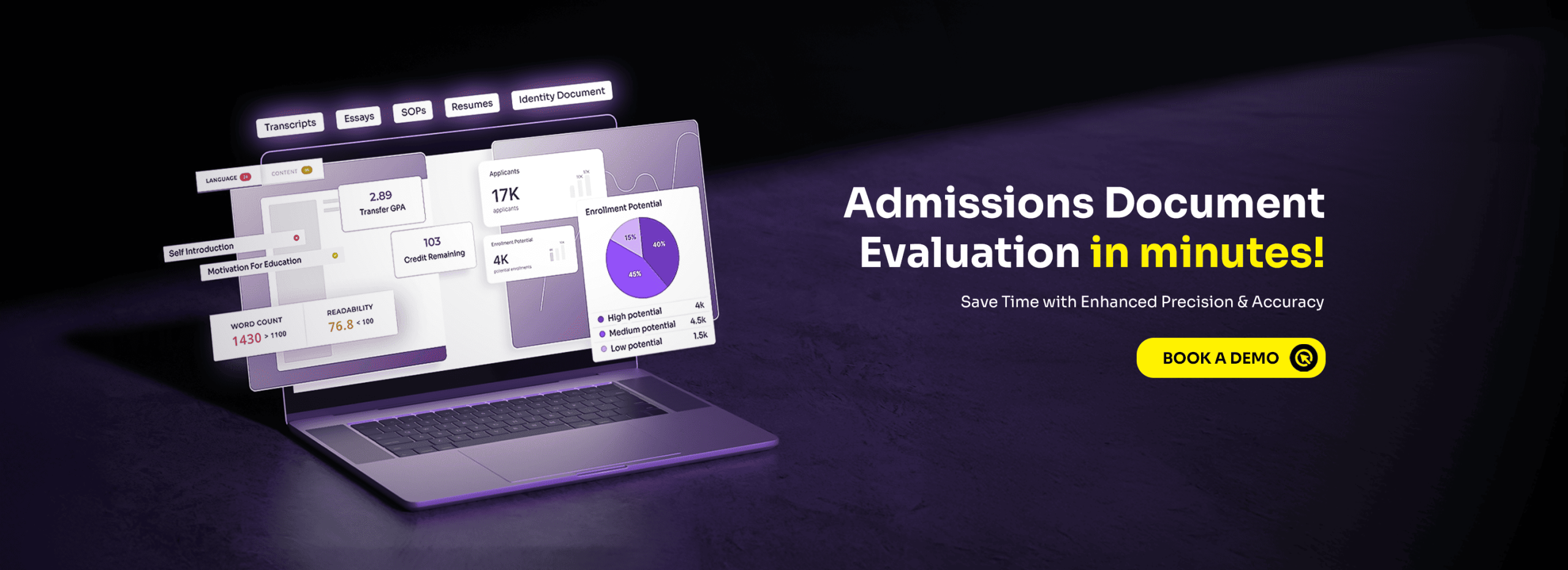Choosing the right enrollment software is essential for colleges and universities aiming to modernize their admissions process. From automated lead management to real-time analytics, today’s platforms offer powerful tools to attract, engage, and convert prospective students efficiently.
Table Of Contents
- 1Introduction
- 2Understanding Enrollment Management Software
- 3Significance of Enrollment Management Software
- 4Who Uses Admissions Software?
- 5Key Features of a Student Enrollment Management System
- 6Top 10 Enrollment Management Software Tools
- 77 Essential Factors to Consider When Choosing Enrollment Software
- 8What Is the ROI of Admissions Software?
- 9Conclusion
Introduction
Colleges and universities are facing major enrollment challenges, especially with international students. According to Fall 2024 data from the Institute of International Education (IIE), 42% of U.S. institutions saw a drop in new international student enrollments, with a 5% year-over-year decline. More recent SEVIS data shows an even bigger 11% drop between March 2024 and March 2025.
To stay competitive, institutions are turning to digital tools to manage admissions more efficiently. In fact, the global admissions software market is expected to grow from USD 1.5 billion in 2024 to USD 3.2 billion by 2033, at a strong 9.2% annual growth rate.
In this blog, we’ll look at the 10 best admissions and enrollment software that help institutions simplify tasks, engage students better, and boost enrollment outcomes.

Understanding Enrollment Management Software
Enrollment software is an integrated technology solution designed to help educational institutions manage the full student enrollment journey — from the initial prospect stage to full enrollment. It automates and streamlines key administrative functions such as admissions, student registration, and tuition billing, which significantly enhances operational efficiency and staff productivity.
The primary goal of software is to centralize student data, monitor enrollment activities, and provide analytical insights. By doing so, student enrollment software supports data-driven decision-making and allows institutions to refine their enrollment strategies more effectively.
Significance of Enrollment Management Software
Higher education enrollment software plays a crucial role in both the daily operations and strategic planning of educational institutions. By automating repetitive administrative tasks and providing real-time data access enables administrators to handle the enrollment process with greater accuracy, efficiency, and speed.
This software also improves the student experience by delivering a seamless and personalized application journey, which can lead to higher engagement and improved enrollment rates.
Who Uses Admissions Software?
While the Provost or Chief Academic Officer typically makes the final decision regarding the adoption of new technology, multiple roles are involved in evaluating and implementing admissions software:
Admissions Counselors: Utilize CRM systems, SMS platforms, and chat tools to maintain ongoing communication with prospective students.
Enrollment Leadership: Focus on improving conversion rates, yield, return on investment (ROI), and making data-driven decisions to optimize the admissions process.
Marketing Teams: Leverage integrated tools to design and execute targeted campaigns, as well as to track and measure their effectiveness.
IT & Operations Teams: Ensure smooth integration of admissions software with the Student Information System (SIS), maintain compliance with regulations, and support long-term scalability.
Key Features of a Student Enrollment Management System
Modern software does more than store student records. It acts as a central platform that connects data, improves communication, and simplifies tasks across departments.
Customizable Workflows and Solutions
Every institution has its own enrollment process, and a reliable enrollment software should offer the flexibility to match that. This includes customizing application forms, automating lead follow-ups, and personalizing student tracking workflows. One graduate school in West Florida reported a 32% increase in admission rates after switching to a more adaptable enrollment system, demonstrating the value of tailored workflows in improving results.
Intuitive, User-Friendly Dashboard
A clean and well-organized dashboard allows staff to manage tasks more efficiently by providing real-time updates on application statuses, pending actions, and critical deadlines. With all key information available at a glance, teams can monitor progress and respond quickly. In fact, a study by the American Association of Colleges and Universities found that using visual reporting tools to monitor student performance boosted retention rates by 11%, showing how intuitive dashboards can directly support better student outcomes.
Applicant Tracking and Communication Tools
A strong admissions system should track applicants from inquiry to final decision while ensuring timely, personalized communication. Features like automated emails, scheduled follow-ups, and integrated engagement tools help keep prospective students informed and interested. South Carolina State University adopted a CRM that included a chatbot for handling enrollment and student success tasks. This strategic move contributed to the university achieving its largest incoming class in five years and a 32% increase in overall enrollment.
Seamless Integration with Existing Systems
Interoperability is essential for smooth operations across campus. A well-designed system should integrate easily with existing platforms like Learning Management Systems (LMS), Student Information Systems (SIS), and Enterprise Resource Planning (ERP) tools. In fact, 88% of U.S. institutions now use CRM systems to streamline processes and enhance staff productivity, showing the growing importance of integrated, campus-wide solutions.
Document Management
Handling student documents manually can slow down the enrollment process and lead to errors. A reliable system should allow for digital submission, easy organization, and real-time tracking of all required documents, making verification faster and more efficient. With EDMO Document Intelligence, institutions can reduce staff manual effort by up to 40%, enabling faster processing and smarter document handling across departments.
Real-Time Analytics and Reporting
Access to real-time data helps institutions make smarter, faster decisions. A good system should track key metrics like inquiry sources and application conversions to identify what’s working. According to the National Center for Education Statistics, colleges that used advanced analytics saw a 30% increase in enrollment stability over five years—proving the power of data-driven strategies.
Task and Inquiry Management
An efficient enrollment pipeline depends on organized task management. Features like to-do lists, reminders, and inquiry tracking help staff stay on top of every lead, ensuring no opportunity is overlooked.
Behavior Tracking and Retention Insights
Tracking student behavior helps identify those at risk of dropping out. If a student stops joining webinars or engaging with content, the system can alert staff to step in and offer support. For example, Georgia State University used behavior-based messaging to boost FAFSA completion by 6% and increase advisor meetings by 29%, leading to stronger student retention.

Top 10 Enrollment Management Software Tools
Choosing the right enrollment management software is critical for institutions looking to enhance student engagement, streamline admissions, and improve overall conversion rates. Below are 10 of the most effective enrollment software solutions available today, each offering features that support a more efficient and data-driven enrollment strategy.
LeadSquared Education CRM
LeadSquared is a powerful education CRM designed to manage the complete student enrollment lifecycle. It allows institutions to automate lead capture, segment students, and build enrollment journeys that convert.
Key Features:
- Customizable enrollment workflows
- Automated lead capture and nurturing
- Mobile-first application processing
- Advanced analytics and reports
- Integration with school systems
Best For: Institutions of all sizes that need a centralized, flexible, and scalable CRM for managing leads and applications.
Success Story: BIMLABS automated its admissions with LeadSquared, leading to a 59% increase in enrollments and reduced manual workload.
Blackbaud Enrollment Management System
Blackbaud offers a robust platform to manage admissions from inquiry to enrollment, with integrated financial aid and document processing capabilities.
Key Features:
- Full admission lifecycle management
- Integrated financial aid and payment processing
- Document tracking and management
- Parent and student portals
Best For: Larger institutions seeking a comprehensive, end-to-end solution with payment and financial aid management.
Success Story: Major higher education institutions like University of Georgia, Syracuse University, and University College London reported enhanced constituent engagement and significant fundraising increases using Blackbaud CRM.
Element451
Element451 brings AI-powered behavioral insights and marketing automation to enrollment. It’s known for helping institutions create dynamic and personalized recruitment campaigns.
Key Features:
- Predictive analytics
- Behavioral engagement tracking
- AI-driven communication automation
- Custom content experiences
Best For: Institutions focused on improving engagement through behavioral data and smart personalization.
Ivy & Ocelot by Gravyty
Ivy & Ocelot is a student engagement platform that helps colleges support applicants 24/7 through AI-powered chat, live support, and text messaging. It reduces staff workload while improving student communication and response rates.
Key Features:
- Answers student questions anytime, even at midnight
- Sends reminders and nudges via text
- Connects students with real advisors for complex queries
- Helps students through every step—from FAFSA to enrollment
Best For: Colleges looking to offer real-time student support without overwhelming their admissions team.
Success Story: Eller College used Ivy & Ocelot’s multilingual chatbot to streamline student inquiries, resolving 76% of FAQs instantly and handling 42% of interactions after hours, enhancing support without added staff strain.
Embark
Embark simplifies the online application process with an intuitive design and workflow automation. It’s especially suitable for institutions looking for a no-fuss, user-friendly platform.
Key Features:
- Simple application builder
- Automated recommendation letters
- Document uploads
- Progress tracking dashboard
Best For: Schools looking for a streamlined, easy-to-navigate online application system.
Slate
Slate is a highly configurable CRM platform designed for full-scale admissions operations. It offers tailored workflows, event management, and territory planning. When paired with EDMO, institutions can unlock intelligent automation and seamless CRM integration enhancing Slate’s capabilities with AI-driven tools for smarter, faster admissions.
Key Features:
- Territory and event management
- Deep workflow customization
- Built-in communication tools
- Advanced analytics
Best For: Institutions needing detailed customization and control over regional and event-based recruitment.
TargetX
Built on the Salesforce platform, TargetX offers tools that blend CRM, mobile recruitment, and social media capabilities to streamline student outreach.
Key Features:
- Social media integration
- Event registration management
- Mobile-friendly tools
- Automated communications
Best For: Institutions leveraging digital channels for mobile-first and socially engaged recruitment.
Read more: Salesforce for Higher Education: Benefits, Drawbacks, and How to Use It Effectively
Pipedrive
Originally built for sales teams, Pipedrive’s CRM is adaptable for educational institutions seeking to manage leads, tasks, and follow-ups through a simple visual interface.
Key Features:
- Pipeline visualization
- Email tracking and automation
- Workflow customization
- Team collaboration tools
Best For: Smaller institutions needing a lightweight, sales-style tool for lead management and communication.
Salesforce Education Cloud
Salesforce Education Cloud offers a 360-degree view of each student, helping institutions manage the entire lifecycle—from prospect to alum—within one unified platform.
Key Features:
- Centralized student profiles
- Marketing automation
- Real-time dashboards and reports
- Integrated alumni and donor management
Best For: Institutions wanting a unified system that connects enrollment, academics, and alumni relations.
Success Story: Central New Mexico Community College used a CRM to unify all stakeholder data, gaining a 360° engagement view and streamlining communication.
Ellucian Banner
Ellucian Banner is a cloud-based Student Information System used by many universities to manage the full student lifecycle, from enrollment to alumni services.
Key Features:
- Enrollment and registration modules
- Cloud scalability
- Mobile and self-service access
- Financial aid and compliance tools
Best For: Universities requiring a scalable, compliant SIS for large student populations.
Success Story: Since 2019, Jacksonville State University has achieved a 30% increase in first-year enrollment, demonstrating the effectiveness of its student enrollment strategies.
Read more: Enrollment Tools: Best Student Enrollment Management Software & Systems
7 Essential Factors to Consider When Choosing Enrollment Software
Selecting the right student enrollment software is critical for ensuring operational efficiency, student satisfaction, and long-term institutional growth. Here are seven key factors to evaluate before making your decision:
Institution Size and Type
Understanding your institution’s structure helps determine the best-fit software.
- Evaluate the current size and enrollment volume
- Assess needs based on the level of education
- Set realistic expectations for growth and future scalability
Integration Capabilities
The software must integrate seamlessly with your existing tools and platforms.
- Check compatibility with current CRM, SIS, and LMS systems
- Ensure API availability for smooth data exchange
- Consider the level of support available for data migration
Budget and ROI
Ensure the investment aligns with your institution’s financial goals.
- Account for ongoing maintenance and subscription fees
- Understand training expenses and resource requirements
- Estimate the long-term return on investment through improved efficiency
User Experience (UX)
A great user experience is essential for adoption by staff and students.
- Ensure mobile accessibility and responsiveness
- Evaluate the effectiveness of the student portal
- Consider the ease of staff onboarding and training
Technical Requirements
Know the technical backbone of the system before implementation.
- Choose between cloud-based or on-premise hosting based on your needs
- Confirm strong security measures (e.g., encryption, two-factor authentication)
- Check for reliable backup and disaster recovery options
Customization and Flexibility
Your software should adapt to your workflows, not the other way around.
- Ensure workflows can be modified for your specific enrollment process
- Look for flexible form customization
- Confirm the ability to generate custom reports
Compliance and Security
Protect student data and meet all legal obligations.
- Evaluate data protection and storage policies
- Confirm adherence to regulations such as FERPA, GDPR, or local laws
- Review built-in privacy controls and audit trails
- Implement granular access controls for staff and users
What Is the ROI of Admissions Software?
While it’s easy to focus on the initial investment, the real value of student admission software lies in the measurable returns it delivers. From boosting enrollment numbers to improving staff efficiency, the right higher ed admissions software offers a strong return on investment by streamlining processes and enhancing the overall admissions strategy.
Lower Cost Per Enrollment
Automating tasks like document processing, inquiry tracking, and applicant communication significantly reduces manual workload. This operational efficiency leads to fewer staff hours spent per applicant, which directly lowers the cost of enrolling each student. In fact, private and independent schools that track ROI effectively report a 15–30% reduction in cost per enrollment after implementing the right tools.
Higher Enrollment Conversion Rates
A streamlined and responsive application process helps keep students engaged and more likely to complete their enrollment. With automation, faster response times, and personalized communication, institutions can convert more inquiries into enrolled students. Schools that use predictive analytics and targeted outreach often see a 15–20% increase in applications within the first year and up to a 25% boost in response rates for their campaigns.
Optimized Resource Allocation
By automating repetitive tasks like data entry and follow-ups, admissions teams can focus more on strategic efforts—such as nurturing leads, strengthening applicant relationships, and boosting engagement. Institutions that adopt advanced business intelligence tools as part of their admissions process report a 20–30% reduction in operational costs, showcasing the impact of smarter resource use.
Enhanced Institutional Value
Beyond financial savings, the software contributes to:
- Streamlined operations
- A better experience for applicants
- Improved staff productivity
- Strengthened institutional reputation
Read more: What is an Admission Management System?
Conclusion
Investing in the right enrollment software can make a significant difference in how institutions attract, engage, and enroll students. From streamlining processes to improving communication and boosting conversion rates, these tools are essential in today’s competitive education landscape.
For colleges and universities, using higher education enrollment software isn’t just about saving time—it’s about making smarter decisions, enhancing the student experience, and achieving long-term enrollment goals more efficiently.










No comments yet. Be the first to comment!
Leave a Comment